Novel Red Phosphor of Gd3+, Sm3+ co-Activated AgxGd((2−x)/3)−0.3−ySmyEu3+0.30☐(1−2x−2y)/3WO4 Scheelites for LED Lighting
Abstract
:1. Introduction
2. Materials and Methods
2.1. Sample Preparation
2.2. Characterization
3. Results
3.1. Crystallography
3.2. Luminescence Properties
4. Discussion
5. Conclusions
Supplementary Materials
Author Contributions
Funding
Institutional Review Board Statement
Informed Consent Statement
Data Availability Statement
Acknowledgments
Conflicts of Interest
References
- Shur, M.S.; Zukauskas, A. Solid-state lighting: Toward superior illumination. Proc. IEEE. 2005, 93, 1691. [Google Scholar] [CrossRef]
- Yam, F.K.; Hassan, Z. Innovative advances in LED technology. Microelectr. J. 2005, 36, 129. [Google Scholar] [CrossRef]
- Haque, M.M.; Lee, H.-I.; Kim, D.-K. Luminescent properties of Eu3+-activated molybdate-based novel red-emitting phosphors for LEDs. J. Alloys Compd. 2009, 481, 792. [Google Scholar] [CrossRef]
- Shao, Q.; Li, H.; Wu, K.; Dong, Y.; Jiang, J. Photoluminescence studies of red-emitting NaEu (WO4)2 as a near-UV or blue convertible phosphor. J. Lumin. 2009, 129, 879. [Google Scholar] [CrossRef]
- Zhang, Y.; Jiao, H.; Du, Y. Luminescent properties of HTP AgGd1−xW2O8: Eux3+ and AgGd1−x(W1−yMoy)2O8: Eux3+ phosphor for white LED. J. Lumin. 2011, 131, 861–865. [Google Scholar] [CrossRef]
- Thangaraju, D.; Durairajan, A.; Balaji, D.; Moorthy Babu, S.; Hayakawa, Y. Novel KGd1−(x+y)EuxBiy(W1−zMozO4)2 nanocrystalline red phosphors for tricolor white LEDs. J. Lumin. 2013, 134, 244. [Google Scholar] [CrossRef]
- Wang, Z.; Zhong, J.; Jiang, H.; Wang, J.; Liang, H. Controllable Synthesis of NaLu(WO4)2:Eu3+ Microcrystal and Luminescence Properties for LEDs. Cryst. Growth Des. 2014, 14, 3767. [Google Scholar] [CrossRef]
- Zhang, W.; Li, J.; Wang, Y.; Long, J.; Qiu, K. Synthesis and luminescence properties of NaLa(MoO4)2−xAGx:Eu3+ (AG = SO42−, BO33−) red phosphors for white light emitting diodes. J. Alloys Compd. 2015, 635, 16. [Google Scholar] [CrossRef]
- Li, G.; Wei, Y.; Li, Z.; Xu, G. Synthesis and photoluminescence of Eu3+ doped CaGd2(WO4)4 novel red phosphors for white LEDs applications. Opt. Mater. 2017, 66, 253. [Google Scholar] [CrossRef]
- Li, W.; Yang, M.; Kang, F.; Sun, G. Color selection and red fluorescence enhancement through the controllable energy transfer in NaxCa1-2xWO4:Eux3+ phosphor for UV converted LEDs. Mater. Chem. Phys. 2018, 207, 396. [Google Scholar] [CrossRef]
- Lu, D.; Gong, X.; Chen, Y.; Huang, J.; Lin, Y.; Luo, Z.; Huang, Y. Synthesis and photoluminescence characteristics of the LiGd3(MoO4)5:Eu3+ red phosphor with high color purity and brightness. Opt. Mater. Exp. 2018, 8, 259–269. [Google Scholar] [CrossRef]
- Guo, W.; Chen, Y.; Lin, Y.; Gong, X.; Luo, Z.; Huang, Y. Spectroscopic analysis and laser performance of Tm3+:NaGd(MoO4)2 crystal. J. Phys. D Appl. Phys. 2008, 41, 115409. [Google Scholar] [CrossRef]
- Chen, Y.J.; Lin, Y.F.; Guo, W.J.; Gong, X.H.; Huang, J.H.; Luo, Z.D.; Huang, Y.D. Efficient 1.9 μm monolithic Tm3+:NaLa(MoO4)2 micro-laser. Laser Phys. Lett. 2012, 9, 141–144. [Google Scholar] [CrossRef]
- Yu, Y.; Zhang, L.; Huang, Y.; Lin, Z.; Wang, G. Growth, crystal structure, spectral properties and laser performance of Yb3+:NaLu(MoO4)2 crystal. Laser Phys. 2013, 23, 105807. [Google Scholar] [CrossRef]
- Feng, J.; Xu, J.; Zhu, Z.; Wang, Y.; You, Z.; Li, J.; Wang, H.; Tu, C. Spectroscopic properties and orthogonally polarized dual-wavelength laser of Yb3+:NaY(WO4)2 crystals with high Yb3+ concentrations. J. Alloys Compd. 2013, 566, 229. [Google Scholar] [CrossRef]
- Meert, K.W.; Morozov, V.A.; Abakumov, A.M.; Hadermann, J.; Poelman, D.; Smet, P.F. Energy transfer in Eu3+ doped scheelites: Use as thermographic phosphor. Optic Exp. 2014, 22, A961. [Google Scholar] [CrossRef]
- Wang, J.; Bu, Y.; Wang, X.; Seo, H.J. A novel optical thermometry based on the energy transfer from charge transfer band to Eu3+-Dy3+ ions. Sci. Rep. 2017, 7, 6023. [Google Scholar] [CrossRef] [Green Version]
- Zhou, X.; Wang, R.; Xiang, G.; Jiang, S.; Li, L.; Luo, X.; Pang, Y.; Tian, Y. Multi-parametric thermal sensing based on NIR emission of Ho (III) doped CaWO4 phosphors. Opt. Mater. 2017, 66, 12. [Google Scholar] [CrossRef]
- Morozov, V.A.; Deyneko, D.V.; Basovich, O.M.; Khaikina, E.G.; Spassky, D.A.; Morozov, A.V.; Chernyshev, V.V.; Abakumov, A.M.; Hadermann, J. Incommensurately Modulated Structures and Luminescence Properties of the AgxSm(2−x)/3WO4 (x = 0.286, 0.2) Scheelites as Thermographic Phosphors. Chem. Mater. 2018, 30, 4788. [Google Scholar] [CrossRef]
- Morozov, V.A.; Batuk, D.; Batuk, M.; Basovich, O.M.; Khaikina, E.G.; Deyneko, D.V.; Lazoryak, B.I.; Leonidov, I.I.; Abakumov, A.M.; Hadermann, J. Luminescence Property Upgrading via the Structure and Cation Changing in AgxEu(2−x)/3WO4 and AgxGd(2−x)/3−0.3Eu0.3WO4. Chem. Mater. 2018, 29, 8811. [Google Scholar] [CrossRef]
- Wang, Z.; Liang, H.; Gong, M.; Su, Q. A potential red-emitting phosphor for LED solid-state lighting. Electrochem. Solid–State Lett. 2005, 8, H33. [Google Scholar] [CrossRef]
- Wang, Z.L.; Liang, H.B.; Gong, M.L.; Su, Q. Novel red phosphor of Bi3+, Sm3+ co-activated NaEu(MoO4)2. Opt. Mater. 2007, 29, 896. [Google Scholar] [CrossRef]
- Mo, F.; Zhou, L.; Pang, Q.; Gong, F.; Liang, Z. Potential red-emitting NaGd(MO4)2:R (M = W, Mo, R = Eu3+, Sm3+, Bi3+) phosphors for white light emitting diodes applications. Ceram. Inter. 2012, 38, 6289. [Google Scholar] [CrossRef]
- Le Bail, A.; Duroy, H.; Fourquet, J.L. Ab-initio structure determination of LiSbWO6 by X-ray powder diffraction. Mater. Res. Bull. 1988, 23, 447. [Google Scholar] [CrossRef]
- Petricek, V.; Dusek, M.; Palatinus, L. Crystallographic computing system JANA2006: General features. Z. Kristallogr. 2014, 229, 345. [Google Scholar] [CrossRef]
- Vokhmintsev, A.S.; Minin, M.G.; Chaykin, D.V.; Weinstein, I.A. A high-temperature accessory for measurements of the spectral characteristics of thermoluminescence. Instrum. Exp. Tech. 2014, 57, 369. [Google Scholar] [CrossRef]
- Arakcheeva, A.; Logvinovich, D.; Chapuis, G.; Morozov, V.; Eliseeva, S.V.; Bunzli, J.-C.G.; Pattison, P. The luminescence of NaxEu3+(2−x)/3MoO4 scheelites depends on the number of Eu-clusters occurring in their incommensurately modulated structure. Chem. Sci. 2012, 3, 384. [Google Scholar] [CrossRef] [Green Version]
- Shi, S.; Liu, X.; Gao, J.; Zhou, J. Spectroscopic properties and intense red-light emission of (Ca, Eu, M)WO4 (M = Mg, Zn, Li). Spectr. Acta Sect. A. 2008, 69, 396. [Google Scholar] [CrossRef]
- Blasse, G. The luminescence of Closed–shell transition–metal complexes. New developments. In Structure and Bonding; Springer: Berlin/Heidelberg, Germany, 1980. [Google Scholar]
- Wiglusz, R.J.; Bednarkiewicz, A.; Strek, W. Role of the Sintering Temperature and Doping Level in the Structural and Spectral Properties of Eu-Doped Nanocrystalline YVO4. Inorg. Chem. 2012, 51, 1180. [Google Scholar] [CrossRef]
- Tanner, P. Some misconceptions concerning the electronic spectra of tri-positive europium and cerium. Chem. Soc. Rev. 2013, 42, 5090. [Google Scholar] [CrossRef]
- Werts, M.H.V.; Jukes, R.T.F.; Verhoeven, J.W. The emission spectrum and the radiative lifetime of Eu3+ in luminescent lanthanide complexes. Phys. Chem. Chem. Phys. 2002, 4, 1542. [Google Scholar] [CrossRef]
- Blasse, G.; Bril, A.; Nieuwpoort, W.C. On the Eu3+ fluorescence in mixed metal oxides: Part I—The crystal structure sensitivity of thr intensity ratio of electric and magnetic dipole emission. J. Phys. Chem. Solids. 1966, 27, 1587. [Google Scholar] [CrossRef]
- Wang, X.Y.; Lin, H.; Li, C.M.; Tanabe, S. Derivation of quantum yields for visible emission transitions of Sm3+ in heavy metal tellurite glass. Opt. Commun. 2007, 276, 122. [Google Scholar] [CrossRef]
- Morozov, V.A.; Raskina, M.V.; Lazoryak, B.I.; Meert, K.W.; Korthout, K.; Smet, P.F.; Poelman, D.; Gauquelin, N.; Verbeeck, J.; Abakumov, A.M.; et al. Crystal Structure and Luminescent Properties of R2−xEux(MoO4)3 (R = Gd, Sm) Red Phosphors. Chem. Mater. 2014, 26, 7124. [Google Scholar] [CrossRef]
- Deyneko, D.V.; Nikiforov, I.V.; Lazoryak, B.I.; Spassky, D.A.; Leonidov, I.I.; Stefanovich SYu Petrova, D.A.; Aksenov, S.M.; Burns, P.C. Ca8MgSm1−x(PO4)7:xEu3+, promising red phosphors for WLED application. J. Alloys Compd. 2019, 776, 897. [Google Scholar] [CrossRef]



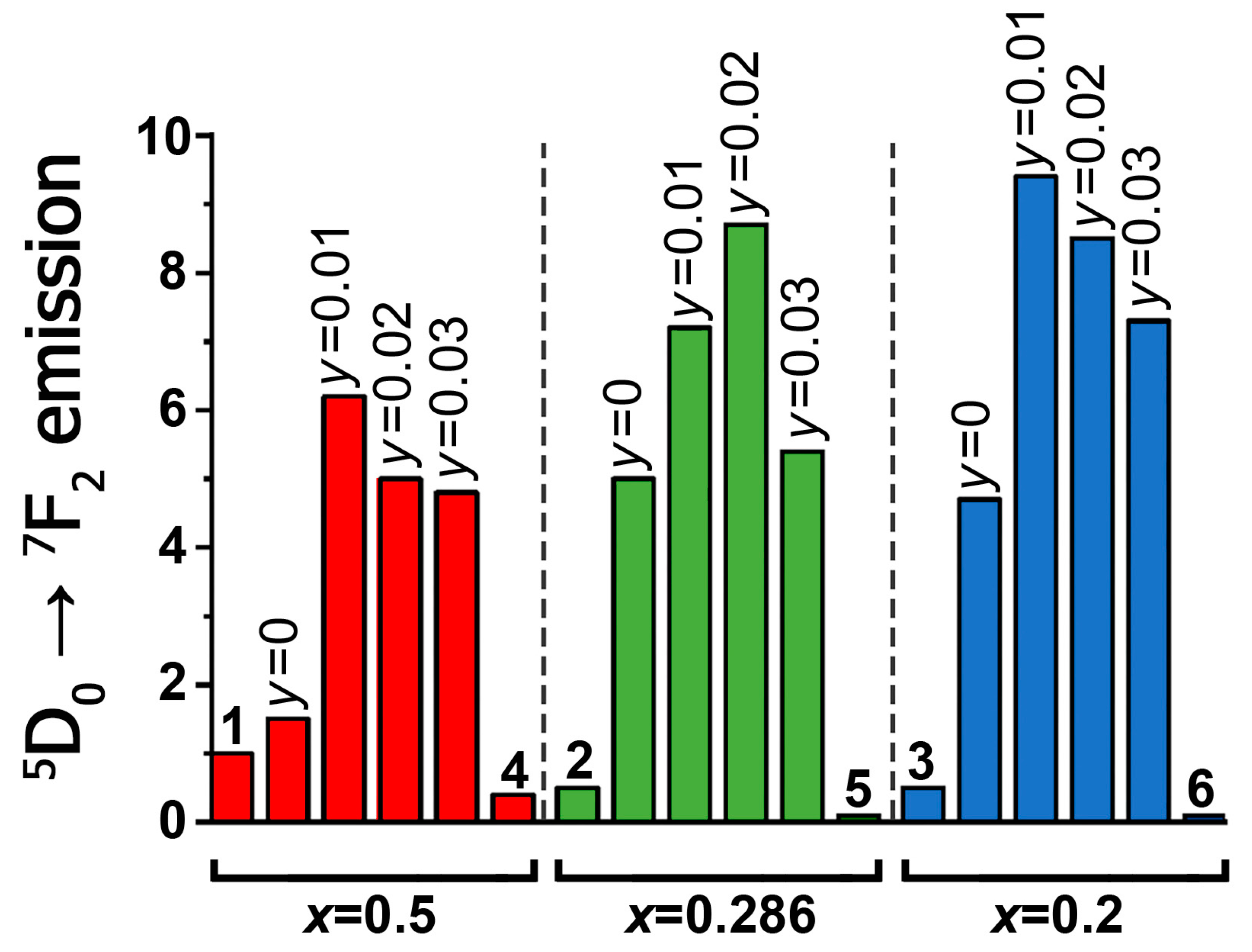
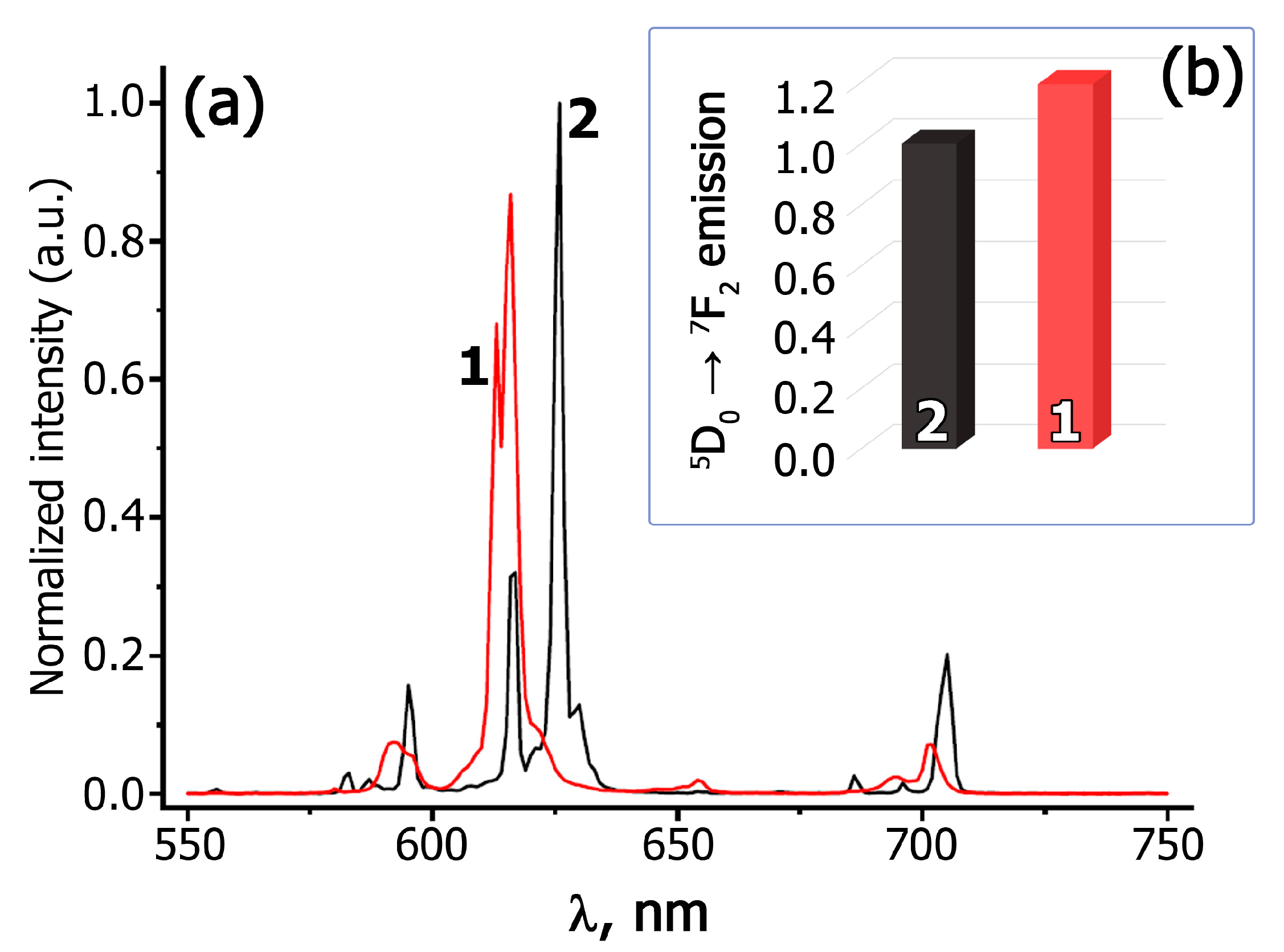

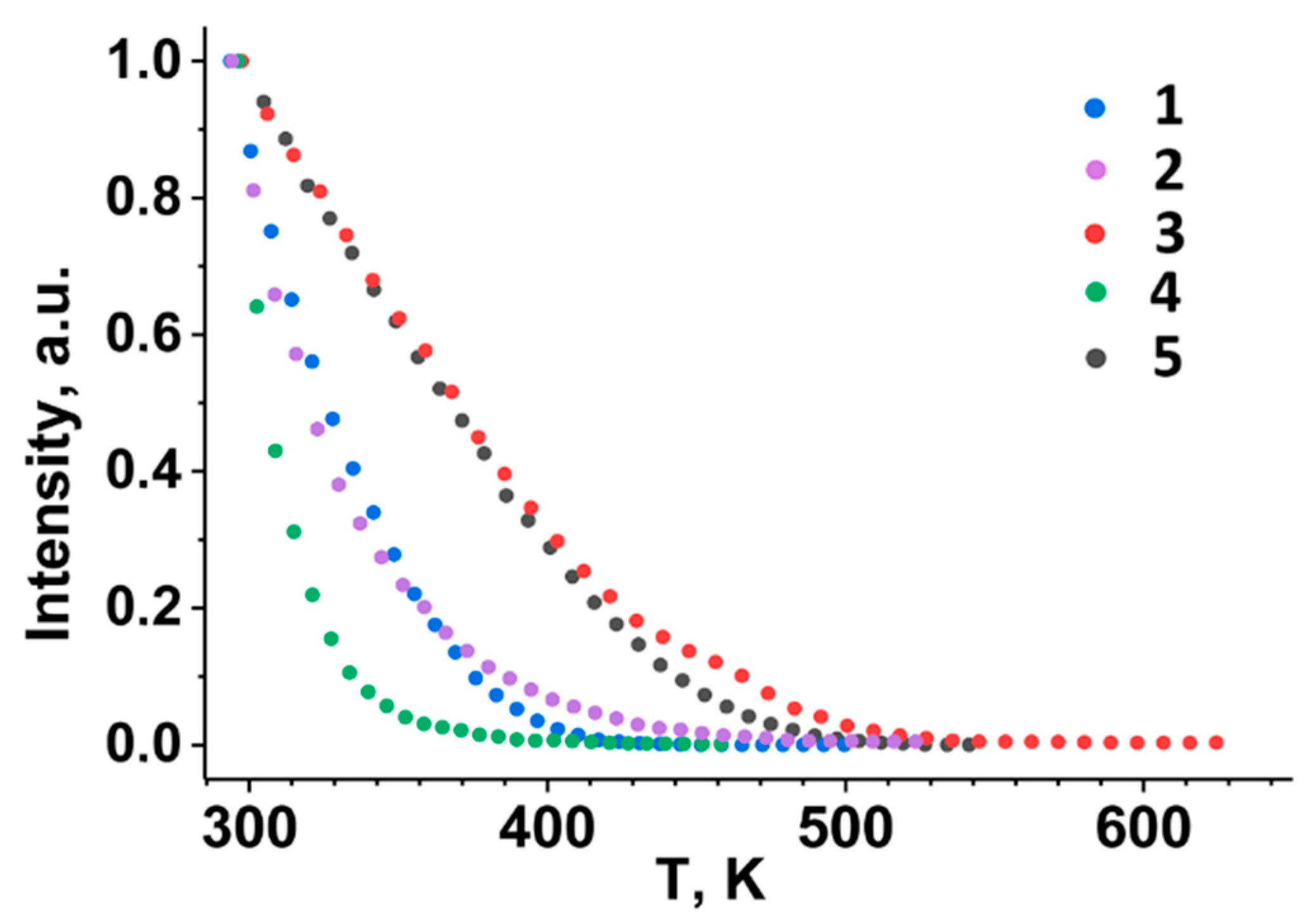
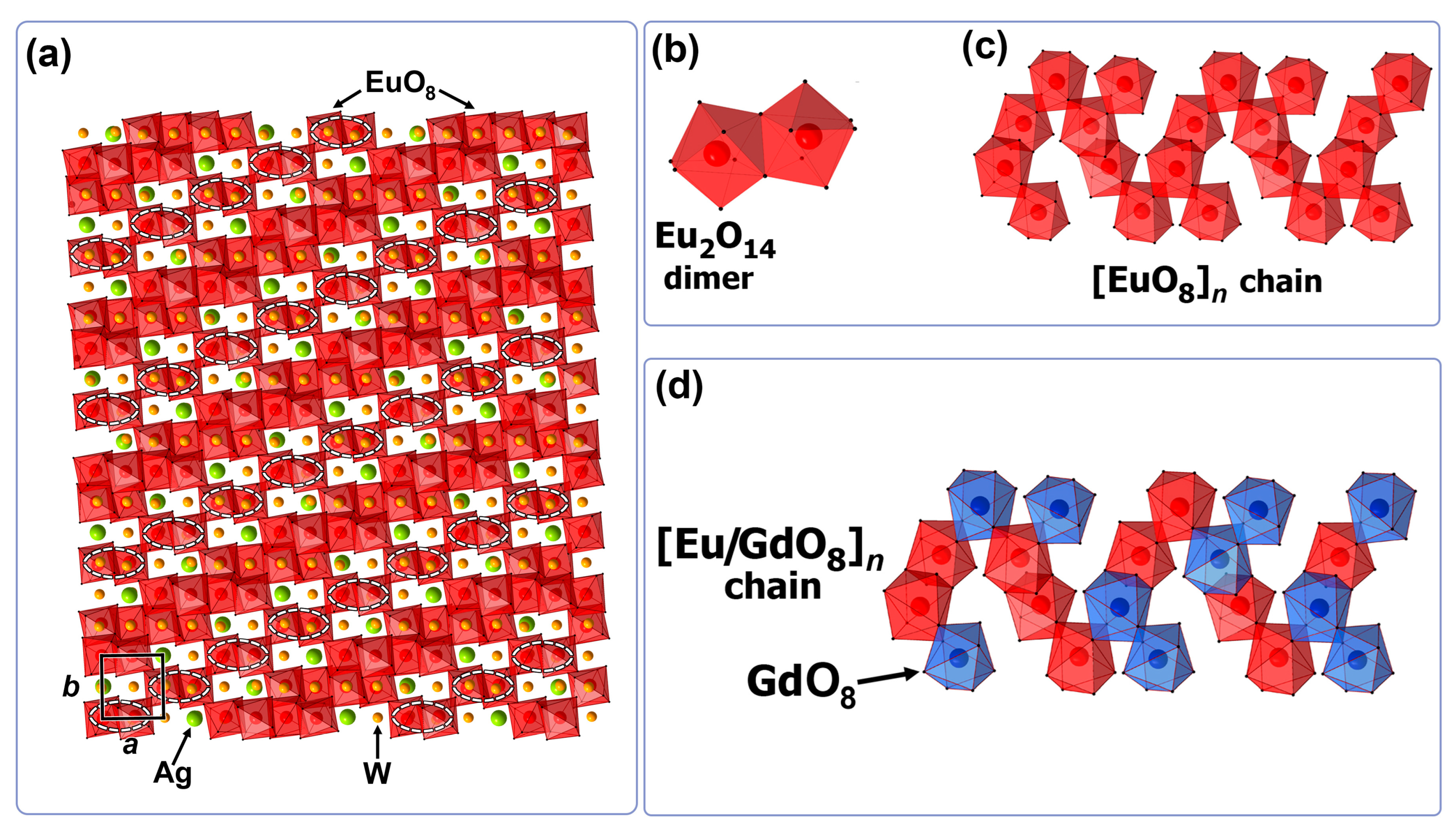

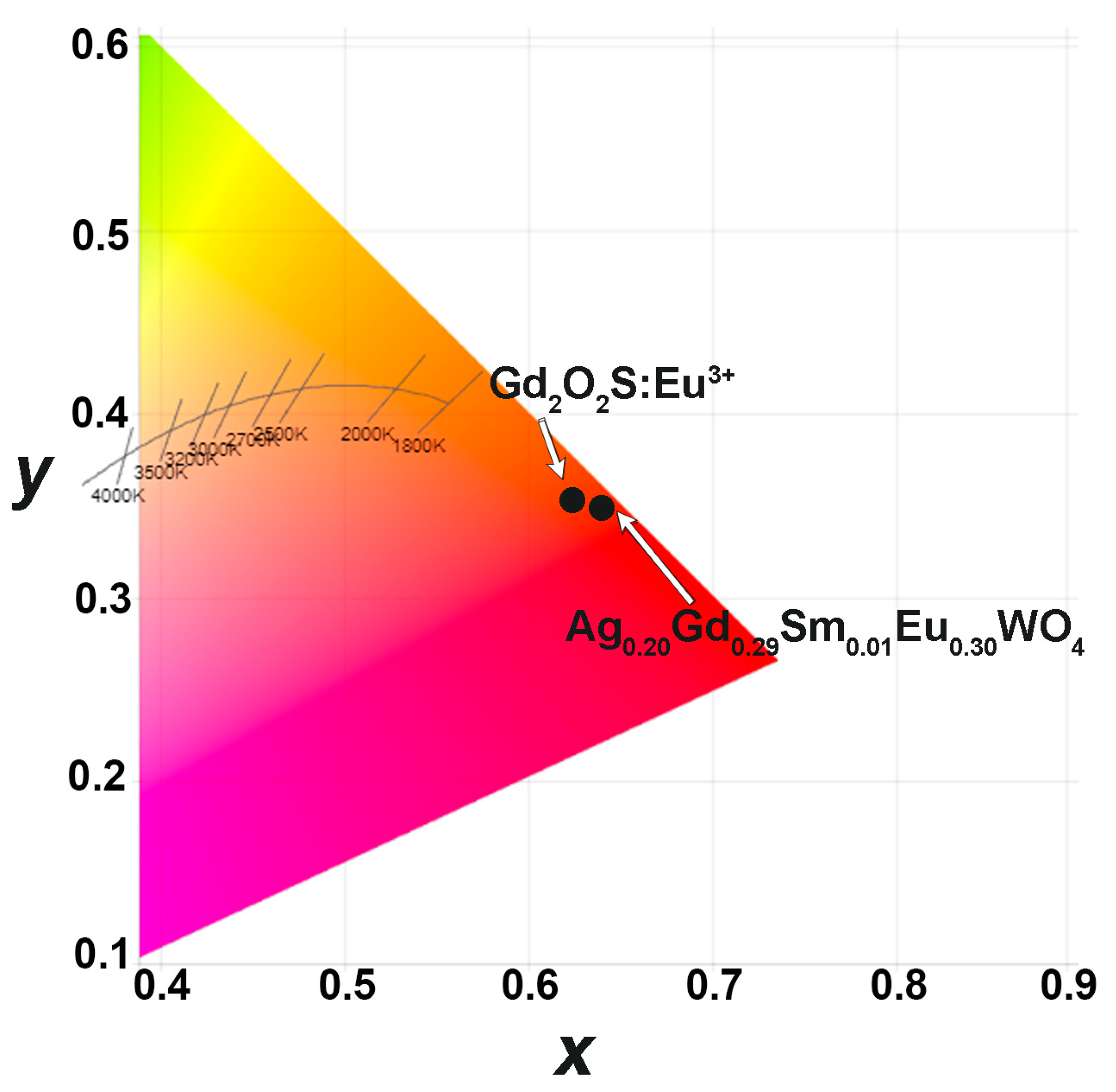
| R((2−x)/3)−0.3 | a, Å | b, Å | c, Å | γ, Deg. | V, Å3 | q | Ref. |
|---|---|---|---|---|---|---|---|
| x = 0.50 (SG I41/a) | |||||||
| Sm0.20 | 5.2780(1) | 11.5340(6) | 321.31(6) | ||||
| Eu0.20 | 5.2787(1) | 11.50026(7) | 320.482(3) | [20] | |||
| Gd0.20 | 5.2740(1) | 11.49348(6) | 319.689(2) | [20] | |||
| x = 0.286 (SSG I2/b(αβ0)00) | |||||||
| Sm0.271 | 5.2311(2) | 5.2950(2) | 11.5501(5) | 91.460(3) | 319.82(3) | 0.602a* + 0.817b* | |
| Eu0.271 | 5.2309(2) | 5.2897(2) | 11.52995(4) | 91.3121(3) | 318.948(1) | 0.586a* + 0.819b* | [20] |
| Gd0.24Sm0.03 | 5.2188(3) | 5.2841(1) | 11.5220(5) | 91.570(3) | 317.62(4) | 0.608a* + 0.806b* | |
| Gd0.25Sm0.02 | 5.2153(1) | 5.2872(1) | 11.5262(2) | 91.561(2) | 317.71(1) | 0.598a* + 0.814b* | |
| Gd0.26Sm0.01 | 5.2169(1) | 5.2902(1) | 11.5292(2) | 91.689(2) | 318.05(1) | 0.601a* + 0.808b* | |
| Gd0.271 | 5.2218(2) | 5.2880(2) | 11.52406(4) | 91.4677(4) | 318.106(4) | 0.585a* + 0.820b* | [20] |
| x = 0.20 (SSG I2/b(αβ0)00) | |||||||
| Sm0.30 | 5.2307(1) | 5.3003(1) | 11.55624(2) | 92.0647(2) | 320.180(1) | 0.591a* + 0.802b* | |
| Eu0.30 | 5.2193(2) | 5.2897(2) | 11.52562(4) | 92.1118(3) | 317.993(1) | 0.591a* + 0.800b* | [20] |
| Gd0.27Sm0.03 | 5.2074(2) | 5.2858(1) | 11.5164(2) | 92.345(3) | 316.73(2) | 0.590a* + 0.801b* | |
| Gd0.28Sm0.02 | 5.2058(1) | 5.2856(1) | 11.5189(4) | 92.345(2) | 316.69(2) | 0.590a* + 0.805b* | |
| Gd0.29Sm0.01 | 5.2049(1) | 5.2839(1) | 11.5181(2) | 92.374(2) | 316.50(1) | 0.592a* + 0.803b* | |
| Gd0.30 | 5.2097(2) | 5.2872(3) | 11.51483(6) | 92.2489(3) | 316.929(3) | 0.592a* + 0.803b* | [20] |
Disclaimer/Publisher’s Note: The statements, opinions and data contained in all publications are solely those of the individual author(s) and contributor(s) and not of MDPI and/or the editor(s). MDPI and/or the editor(s) disclaim responsibility for any injury to people or property resulting from any ideas, methods, instructions or products referred to in the content. |
© 2023 by the authors. Licensee MDPI, Basel, Switzerland. This article is an open access article distributed under the terms and conditions of the Creative Commons Attribution (CC BY) license (https://creativecommons.org/licenses/by/4.0/).
Share and Cite
Morozov, V.A.; Lazoryak, B.I.; Savina, A.A.; Khaikina, E.G.; Leonidov, I.I.; Ishchenko, A.V.; Deyneko, D.V. Novel Red Phosphor of Gd3+, Sm3+ co-Activated AgxGd((2−x)/3)−0.3−ySmyEu3+0.30☐(1−2x−2y)/3WO4 Scheelites for LED Lighting. Materials 2023, 16, 4350. https://doi.org/10.3390/ma16124350
Morozov VA, Lazoryak BI, Savina AA, Khaikina EG, Leonidov II, Ishchenko AV, Deyneko DV. Novel Red Phosphor of Gd3+, Sm3+ co-Activated AgxGd((2−x)/3)−0.3−ySmyEu3+0.30☐(1−2x−2y)/3WO4 Scheelites for LED Lighting. Materials. 2023; 16(12):4350. https://doi.org/10.3390/ma16124350
Chicago/Turabian StyleMorozov, Vladimir A., Bogdan I. Lazoryak, Aleksandra A. Savina, Elena G. Khaikina, Ivan I. Leonidov, Alexey V. Ishchenko, and Dina V. Deyneko. 2023. "Novel Red Phosphor of Gd3+, Sm3+ co-Activated AgxGd((2−x)/3)−0.3−ySmyEu3+0.30☐(1−2x−2y)/3WO4 Scheelites for LED Lighting" Materials 16, no. 12: 4350. https://doi.org/10.3390/ma16124350





